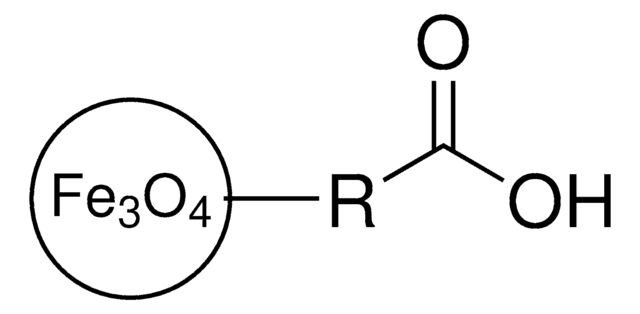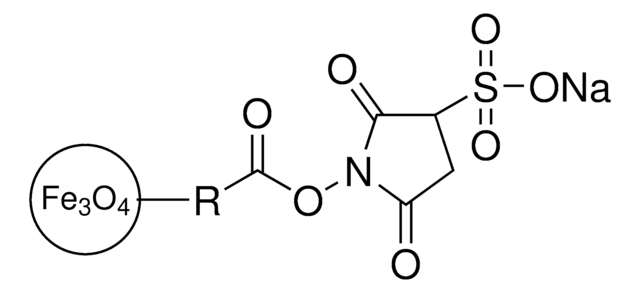747327
Eisenoxid(II,III), magnetische Nanopartikel -Lösung
30 nm avg. part. size (TEM), amine functionalized, 1 mg/mL Fe in H2O, dispersion
Synonym(e):
Magnetische Eisenoxid Nanokristalle, Magnetit, Superparamagnetische Eisenoxid Nanopartikel
About This Item
Empfohlene Produkte
Form
dispersion
nanoparticles
Qualitätsniveau
Konzentration
1 mg/mL Fe in H2O
Magnetisierung
>45 emu/g, at room temperature; under 4500 Oe
Farbe
black
Durchschnittliche Teilgröße
30 nm (TEM)
Dichte
~1 g/mL at 25 °C
Funktionelle Gruppe
amine
Lagertemp.
2-8°C
SMILES String
O=[Fe].O=[Fe]O[Fe]=O
InChI
1S/3Fe.4O
InChIKey
SZVJSHCCFOBDDC-UHFFFAOYSA-N
Suchen Sie nach ähnlichen Produkten? Aufrufen Leitfaden zum Produktvergleich
Verwandte Kategorien
Allgemeine Beschreibung
Anwendung
Rechtliche Hinweise
Lagerklassenschlüssel
12 - Non Combustible Liquids
WGK
WGK 2
Flammpunkt (°F)
Not applicable
Flammpunkt (°C)
Not applicable
Analysenzertifikate (COA)
Suchen Sie nach Analysenzertifikate (COA), indem Sie die Lot-/Chargennummer des Produkts eingeben. Lot- und Chargennummern sind auf dem Produktetikett hinter den Wörtern ‘Lot’ oder ‘Batch’ (Lot oder Charge) zu finden.
Besitzen Sie dieses Produkt bereits?
In der Dokumentenbibliothek finden Sie die Dokumentation zu den Produkten, die Sie kürzlich erworben haben.
Kunden haben sich ebenfalls angesehen
Artikel
Iron oxide (IO) nanoparticles consist of maghemite (γ-Fe2O3) and/or magnetite (Fe3O4) particles with diameters ranging from 1 and 100 nanometer and find applications in magnetic data storage, biosensing, drug-delivery etc.
Professor Mitsuhiro Ebara provides insights on several types of smart nanofiber mesh systems that have been explored for different drug delivery purposes.
The recent emergence of a number of highly functional nanomaterials has enabled new approaches to the understanding, diagnosis, and treatment of cancer.
Professor Yadong Yin (University of California Riverside, USA) examines both direct (thermal decomposition, solvothermal, hydrothermal) and indirect (templated) synthesis methods of magnetite nanocrystals and reviews in detail the landscape of these various synthetic methods for magnetite nanocrystal and their applications in magnetic assembly, magnetic hyperthermia, and Li-Ion batteries.
Unser Team von Wissenschaftlern verfügt über Erfahrung in allen Forschungsbereichen einschließlich Life Science, Materialwissenschaften, chemischer Synthese, Chromatographie, Analytik und vielen mehr..
Setzen Sie sich mit dem technischen Dienst in Verbindung.


